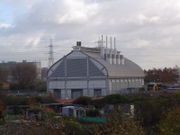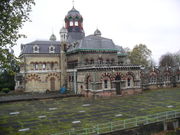London sewerage system
2007 Schools Wikipedia Selection. Related subjects: Engineering
In the early 19th century the River Thames was practically an open sewer, with disastrous consequences for public health in London, including a seemingly endless sequence of cholera epidemics. Proposals to modernise the system had been put forward in 1856 but were shelved due to lack of funds, but after The Great Stink of 1858, Parliament realised the urgency of the problem and resolved to create a modern sewerage system.
Joseph Bazalgette, a civil engineer and Chief Engineer of the Metropolitan Board of Works, was given responsibility for the work. He designed an extensive underground sewerage system that diverted waste to the Thames Estuary downstream of the main centre of population. Six main interceptory sewers, totalling almost 100 miles (160 km) in length, were constructed, some incorporating stretches of London's 'lost' rivers. Three of these sewers were north of the river, the southernmost, low-level one being incorporated in the Thames Embankment. The Embankment also allowed new roads to reduce traffic congestion, new public gardens, and the Circle Line of the London Underground.
The interceptory sewers, constructed between 1859 and 1865, were fed by 450 miles (720 km) of main sewers that, in turn, conveyed the contents of some 13,000 miles (21,000 km) of smaller local sewers. Construction of the interceptory system required 318 million bricks, 880,000 cubic yards (670,000 m³) of concrete and mortar, and excavation of over 3.5 million tonnes of earth.
Gravity was used to allow the sewage to flow eastwards, but in places (e.g. Chelsea, Deptford and Abbey Mills) pumping stations were built to raise the water and provide sufficient flow. Sewers north of the Thames feed into the Northern Outfall Sewer, which feeds into a major treatment works at Beckton. South of the river, the Southern Outfall Sewer extends to a similar facility at Crossness.
In the 20th century major improvements were made to the sewerage system, to reduce pollution of the Thames Estuary and the North Sea.
The system plays a large part in English writer Neil Gaiman's 1996 novel Neverwhere. It also featured as one of the Seven Wonders of the Industrial World in the BBC television series of the same name.
The Victorian pipes now amount to less than 1% of the total sewage network in London. The original system was designed to cope with up to 6.5mm (1/4”) of rain falling in its catchment’s area . The London it was designed for had a lot smaller population than today’s population . The consequences of the continued growth of London meant that the carrying capacity of the sewage system that was built in the past has been put under pressure. When there is a storm with a high level of rainfall (in excess of 6mm),in a short period of time, London’s sewers are unable to cope with the large amount of rainwater entering the system and the capacity of the treatment stations is overwhelmed by the sheer volume of water. The rainwater mixes with foul sewage in combined sewers and, when the treatment system cannot cope, Thames Water discharges the excess mixed water into the Thames. If this does not happen fast enough, localised flooding occurs (surcharge). This can mean that areas of streets can become flooded with a mixture of water and sewage, causing a health risk. The need for increasing the carrying capacity of London’s sewer system has been debated for a number of years. However, since the cost of upgrading the sewage system’s infrastructure to cope with revised estimates of needed capacity is huge, the question of who bears the cost is at the forefront.

